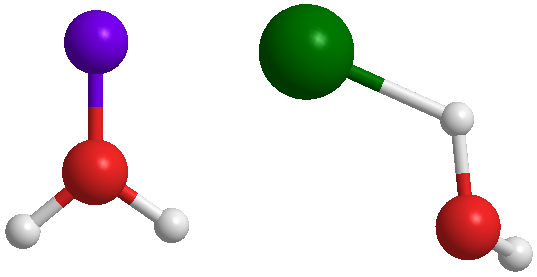Sea water and sodium chloride
Sea water is a very common substance, covering more than 70% of the Earth's surface. Sea water contains a variety of "salts". In this experiment, you will investigate some properties of water, salts and sea water itself.
Salts are ionic compounds. The atoms in ionic compounds are ions: they have positive and negative charges and these attract one another to hold the atoms in place. Often this attraction is so strong that salts form solid crystals which require very high temperatures to melt.
In sodium chloride, the sodium atoms are positively charged, and are called the "cations", and the chlorine atoms are negatively charged, and are called the "anions". Solid sodium chloride contains very many cations and anions. These pack are closely as they can to one another to maximize the attraction. The result is a regular crystal. As you can see from the animation, the ions pack together to form cubes and these pack to form even larger cubes. In this experiment, you will make a crystal of sodium chloride and this should also be cubic because it is simply a very, very large version of the model shown here. A single gram of salt contains (approximately) 10000000000000000000000 cations and 10000000000000000000000 anions.1 × 1022 is about the same as the total number of grains of sand on the planet. Each sodium cation has one less electron than a sodium atom so has a positive charge of +1. The sodium cation is given the symbol Na+. Each chlorine anion has one extra electron than a chlorine atom so has a negative charge of -1. The chlorine anion is given the symbol Cl+. To keep the number of positive and negative ions the same, there must be an equal number of each and so there is one sodium atom for every one chlorine atom in sodium chloride. This is true whether the crystal is made up over only a few hundred or 1022 ions. The formula of the compound is thus NaCl(s) where the "(s)" shows us that it is a solid. |
|
A crystal is really one extremely large collection of Na+ and Cl- ions. Water, however, is made up of lots of separate "molecules". Each molecule contains two hydrogen atoms attached ("bonded") to one oxygen atom. The formula of liquid water is thus H2O(l) where the "(l)" shows us that it is a liquid.
It is relatively easy to separate the molecules and turn liquid water into water vapour. When you boil water, you are not breaking the bonds inside the molecules: H2O(g) (with "(g)" for gaseous) still contains two hydrogen atoms bonded to one oxygen atom. Each water molecule is bent (or "V shaped"). It has no overall charge but the oxygen atom has a small negative charge and the two hydrogen atoms have balancing positive charges. The V shape and these small charges give water its unique properties, which all life on Earth rely on. One of these properties is that the oxygen atom on one water molecule is attracted to the hydrogen atoms on other water molecules. This attraction between water molecules is called a "hydrogen bond". Because of hydrogen bonds, we need to heat water to 100 °C to boil it. Without hydrogen bonds, water would be a gas even at normal temperatures and life on Earth would not be possible. |
|
Another consequence of the V shape and the small negative charge on the oxygen atom and small positive charges on the hydrogen atoms in each water molecule is the ability of water to dissolve salts. Again, life depends on this.
When a salt such as sodium chloride dissolves in water, the ions become separated. The cations become surrounded by water molecules with the negatively charged O ends close to the positively charged ion. The anions also become surrounded but it is the negatively charged H ends which are closer to the negative ion. When ions are surrounded by water molecules in this way, they are said to be "hydrated". To emphasize that ions are hydrated, their formulas are written with an "(aq)" attached. When NaCl(s) dissolves in water, Na+(aq) and Cl-(aq) ions are formed. In sea water, there are (approximately) 100 water molecules for every 1 Na+(aq) and for every 1 Cl-(aq) ion. A single millilitre of seawater contains (approximately) 30000000000000000000000 water molecules and 300000000000000000000 Na+ and Cl- ions, or |
|
